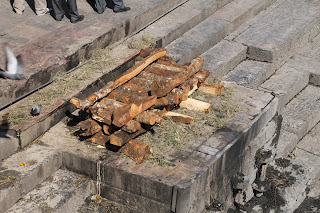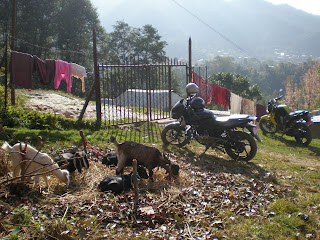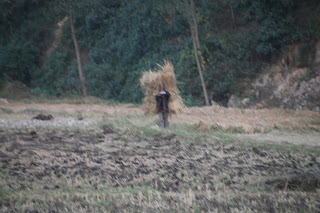The first piece of advice I received before stepping out the hotel's front door to walk the streets of Katmandu from Andrew, the project's president shortly after arriving in Nepal was, "make sure you yield to anything bigger than you". Seems like a simple enough concept for anyone to understand and applies to just about any environment where you travel, right? I learned quickly that although this advice was accurate and helpful, it only applies to places in the city where there is actually a space to yield!
Walking around Katmandu is not easy. Matter of fact, the simplest of jaunts around city blocks ( or lack of) is downright mentally and physically exhausting. Sidewalks barely exist. When they do they are often uneven, rugged and full of holes. Walking on the streets is more common but the conditions are usually worse than the sidewalks. Sometimes gravel. Sometimes brick. Sometimes pavement. They are always full of potholes, scattered with animal waste, sewage sludge and trash. And traffic. Lots of traffic. So as one eye is watching the ground where you step to keep forward momentum the other is making sure you do not get hit, knocked down or run over. Either by motorcycle, car, van, bus, rickshaw, cart, tractor, bicycle, pedestrian, young children or livestock. Cattle roam freely on the streets. So do ducks, geese, chickens, goats and dogs but they present less threat. At the same time your senses begin to become stimulated often to the point of becoming overwhelmed. Horns beeping, engines rumbling, sirens blaring, school kids yelling, dogs barking, whistles blowing and chanting all fill your ears. The smell of sewage, burning fuel, incense, trash and meals being prepared provide a contrasting fragrance. Bright colors illuminate narrow alleys from shops, markets, homes and temples making many areas blend together creating a maze where it becomes easy to get lost. And the energy from the city's movement is felt radiating through your body. It is only when you are able to stop and slow down that you begin to notice the little things that are special and unique. You can begin to focus on the beauty and character of the people and their culture. You notice the passion and begin to understand the spirit in their beliefs. You see the beauty in the architecture and the connection to history. Consequently, everything that once seemed so foreign and obscure begins to become comfortable, common and familiar. Eventually, "yielding" becomes an adventure overcome by an unconscious competency while exhaustion transforms to enlightenment and joy. But at some point you must walk again and the cycle starts all over.
 |
| Log Pyres |
 |
| Funeral preparation |
 |
| Oldest son's hair removal before his parents cremation. |
 |
| Cremation ghats |
 |
| fertility temples |
 |
| Boudha Stupa |
 |
| Bouhda Stupa |
 |
| Hindu funeral |
 |
| The eyes of Buddha on the Great Stupa |
 |
| fertility temples |
 |
| The deceased having their feet cleansed before cremation. |
 |
| Y,ou can get your picture taken ( for a fee) with a "fake" holyman in tourist areas. |
The first two days after arriving were spent getting to know parts of Katmandu and the other practitioners making up our clinical team. As a group we explored some of the more popular tourist sites including the holy area of Pashupatinath, Boudhanath and Durbar Sqaure. The Pashupatinath is Nepal's most sacred Hindu cremation site. Along the Bagmati river log pyres are situated on cremation ghats where bodies are carried to by barefooted pallbearers. Once there, the body is lowered into the river and the feet are washed. After the oldest son's hair is cut he performs the rites which includes filling the mouth of the deceased with fuel to begin the cremation process. Once the body is in flames the mourners retreat to observe the process along the banks of the river along with anyone else who care to witness the open air ceremony. A few hours later the ashes are swept into the river. Along the opposite side of the river are fertility temples where new life is celebrated and worshipped. The Boudhanath is the home of the Great Stupa where the practices of Buddhism is showcased. The eyes of the Buddha are situated at the highest point of the Stupa just above the symbol representing the concept of one. Crowds of people walk clockwise around the Stupa for ritual all hours of the day. Durbar Square is Katmandu's old city center with temples dating back to the 12th century. In the square is the Kumari Bahal which is home of the young girl chosen to serve as the Royal Kumari. She is considered the emanation of the fierce Hindu goddess. She only makes appearances in public at festivals otherwise sitings are considered an honor and happen rarely. On the day of our visit she did provide us a glimpse as she revealed her painted face briefly through her upper window. Pictures of the Kumari are absolutely forbidden. In addition to observing these sites, we leisurely explored the streets of Thamel and Boudha looking through shops and sampling the local cuisine of daal bhaat and rice dishes fried with water buffalo. Once we "settled" in, recovered from jet lag and got adjusted to the pace of the city some last minute supplies where purchased as we prepared to relocate to the village of Chapagoan to begin practicing in the Vajra Varahi Healthcare Clinic.




















































